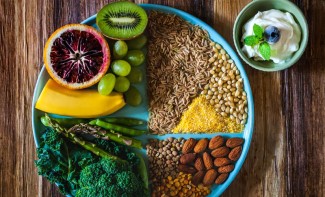
A plant-based diet rich in whole grains, healthy fats, vegetables, legumes, nuts, and seeds is the ideal way to help balance blood sugar levels and may help reduce your risk of diabetes. Specific foods within these categories are especially beneficial in keeping your blood sugar in check. Read on for some ideas about how to incorporate these healthful foods into your diet.
Whole grains
Whole grains, especially oats and barley, are helpful for blood sugar levels because they are high in soluble fiber and are slower to digest than other carbohydrates. Slower digestion creates a smaller fluctuation in blood sugar compared with refined carbohydrates.1 Try starting your day with a bowl of oatmeal (not the pre-sweetened kind) and replace rice with barley in your meals.
Fresh vegetables
Diabetes experts recommend including plenty of non-starchy vegetables such as broccoli, green beans, spinach, kale and other leafy greens.2 These vegetables are low in carbohydrates, high in dietary fiber and rich in magnesium. The National Institutes of Health report that magnesium helps regulate blood sugar levels and promotes normal blood pressure.3 Starchy vegetables such as white potatoes, peas and corn should be consumed only in small amounts as they have the effect of raising blood sugar much more dramatically.
Legumes
Legumes are a high-fiber, high-protein, complex carbohydrate with significant amounts of magnesium. The legume family includes black beans, pinto beans, garbanzo beans, soybeans, kidney beans and lentils, to name a few. Substituting legumes for foods that are high in saturated fats or refined carbohydrates is a powerful step to help lower your risk of type 2 diabetes.4
Nuts and Seeds
Nuts and seeds are another excellent source of magnesium.5 They are also high in protein, fiber and healthy fats. These qualities combined with the fact that nuts and seeds are filling and usually very convenient to pack, make them a perfect on-the-go snack. You can also try a variety of nut butters such as almond, cashew or sunflower butter in addition to common peanut butter. Don’t forget flaxseeds – ground flaxseed can be sprinkled on top of your oatmeal for an extra nutritional boost in the morning!
Cinnamon
Recent studies examining the effect of cinnamon on blood sugar levels have had promising results. One such study, reported in the American Diabetes Association Journal, concludes that as little as one gram of cinnamon per day improves blood sugar, triglyceride, LDL cholesterol and total cholesterol in people with type 2 diabetes.6 Cinnamon is a simple addition to savory meals like soups and curries, as another healthful topping to your oatmeal, or sprinkled on whole grain toast. Cinnamon is also available in supplement form. A balanced vegetarian diet will automatically include many of these nutritious foods. Just by making the move to a more plant-based diet you are taking a step toward diabetes prevention.
- Higdon, J. P. (2009, May). Micronutrient Information Center: Whole Grains. Retrieved October 6, 2011, from Oregon State University, Linus Pauling Institute.
- Kam, K. (n.d.). Diabetic Diet: 6 Foods That May Help Control Blood Sugar. Retrieved Ocotber 5, 2010, from Web MD.
- National Institutes of Health. (2009, July 13). Dietary Supplement Fact Sheet: Magnesium. Retrieved October 6, 2011, from Office of Dietary Supplements.
- Higdon, J. P. (2009, April). Micronutrient Information Center: Legumes. Retrieved October 6, 2011, from Oregon State University, Linus Pauling Institute.
- Gamble, D. (2010, November 24). Foods for maintaining blood sugar levels. Retrieved October 6, 2011, from Live Strong.
- Alam Khan, M. P. (2003, December). Cinnamon Improves Glucose and Lipids of People With Type 2 Diabetes. Retrieved October 6, 2011, from American Diabetes Association.